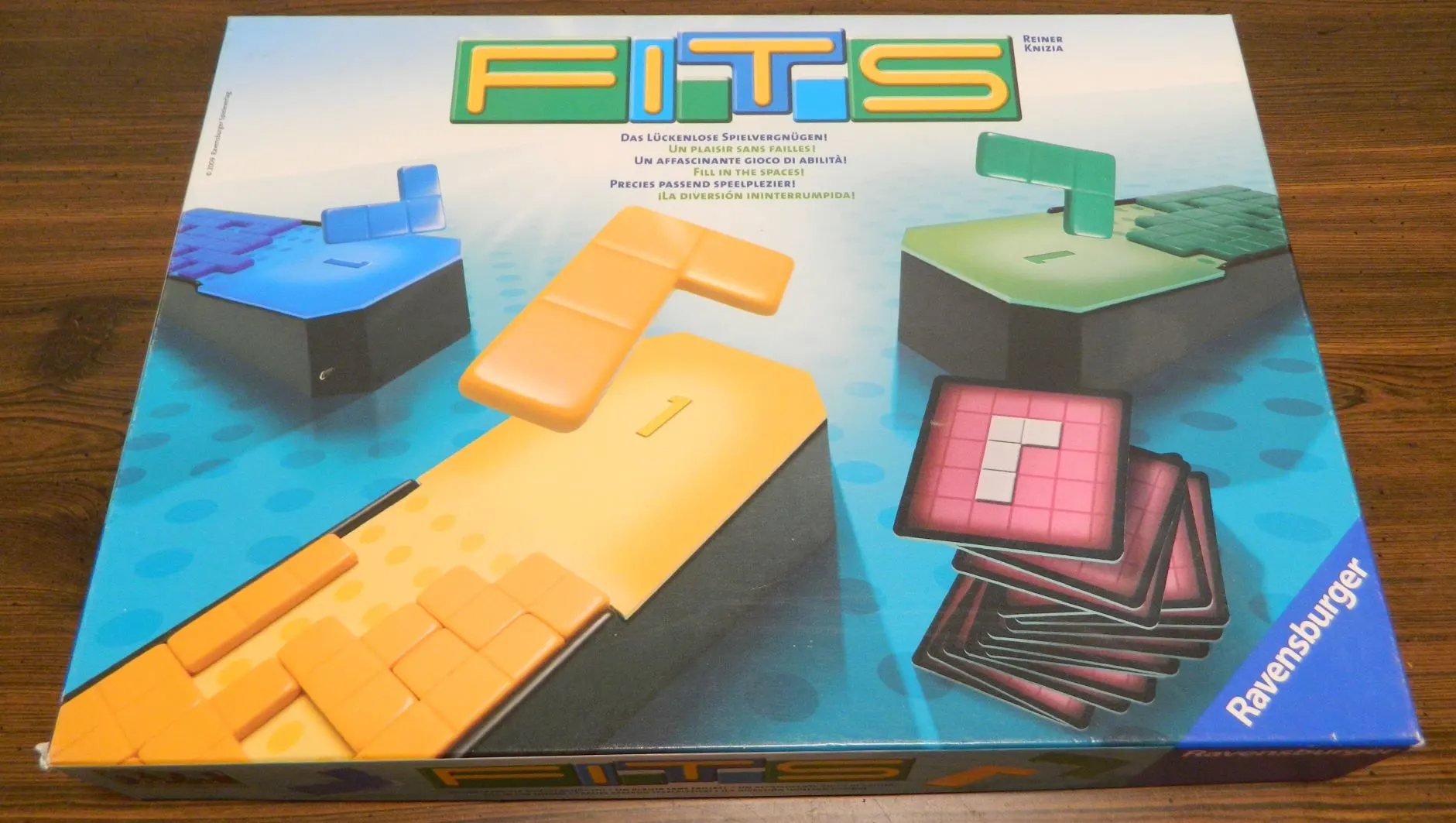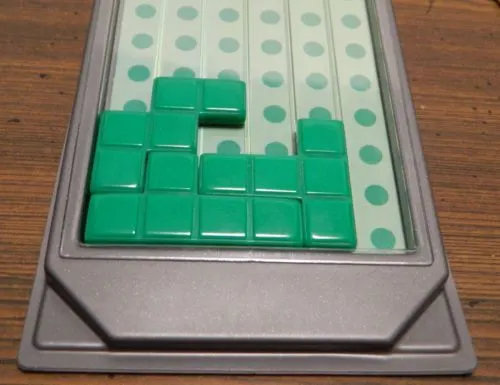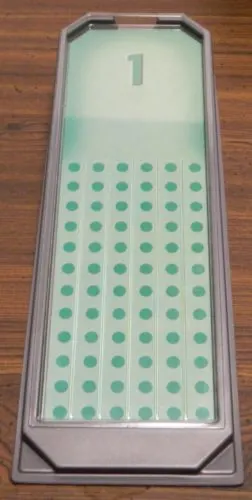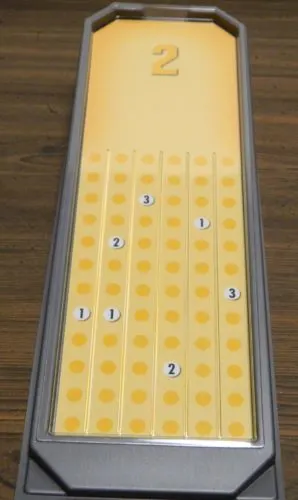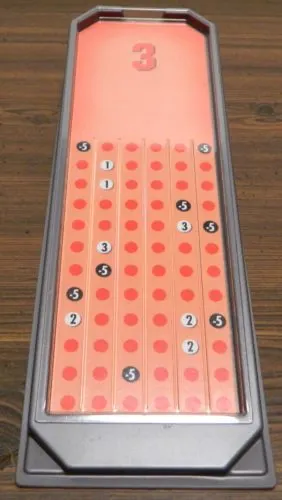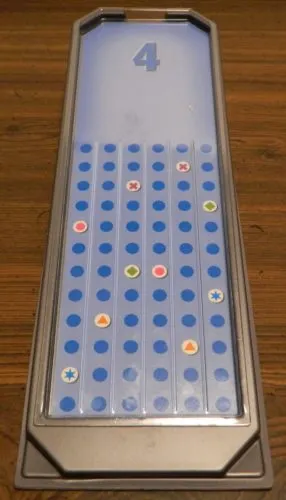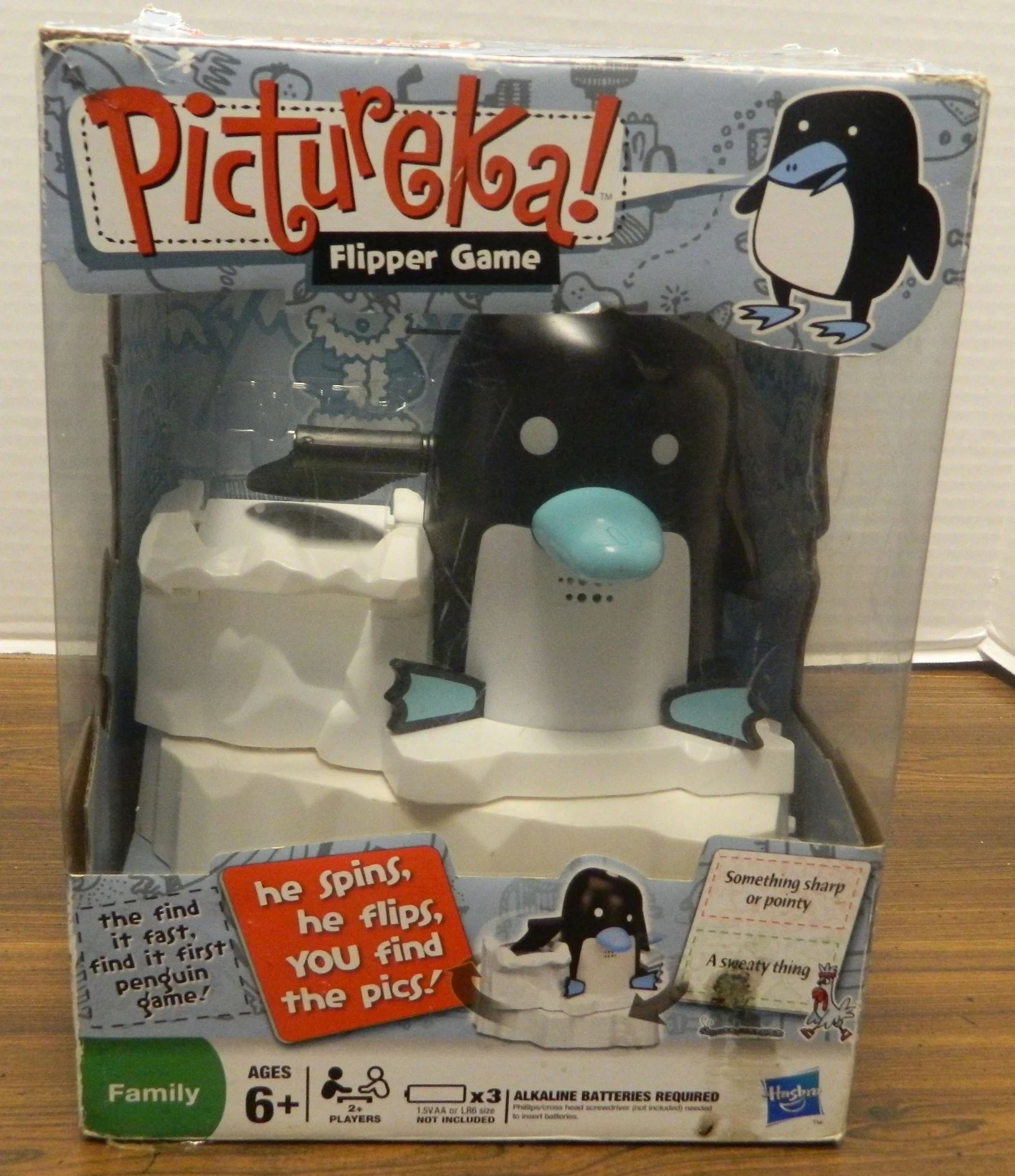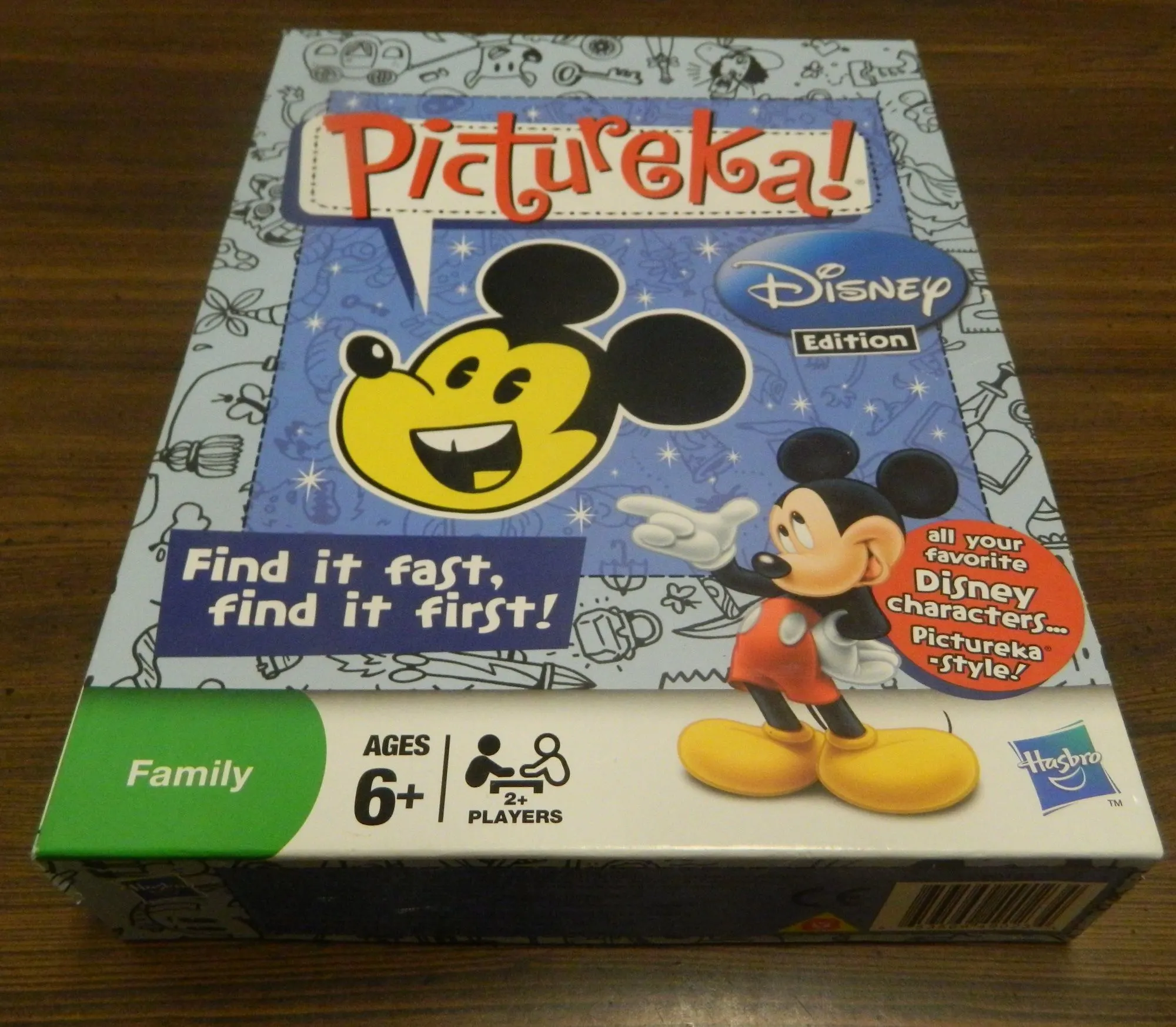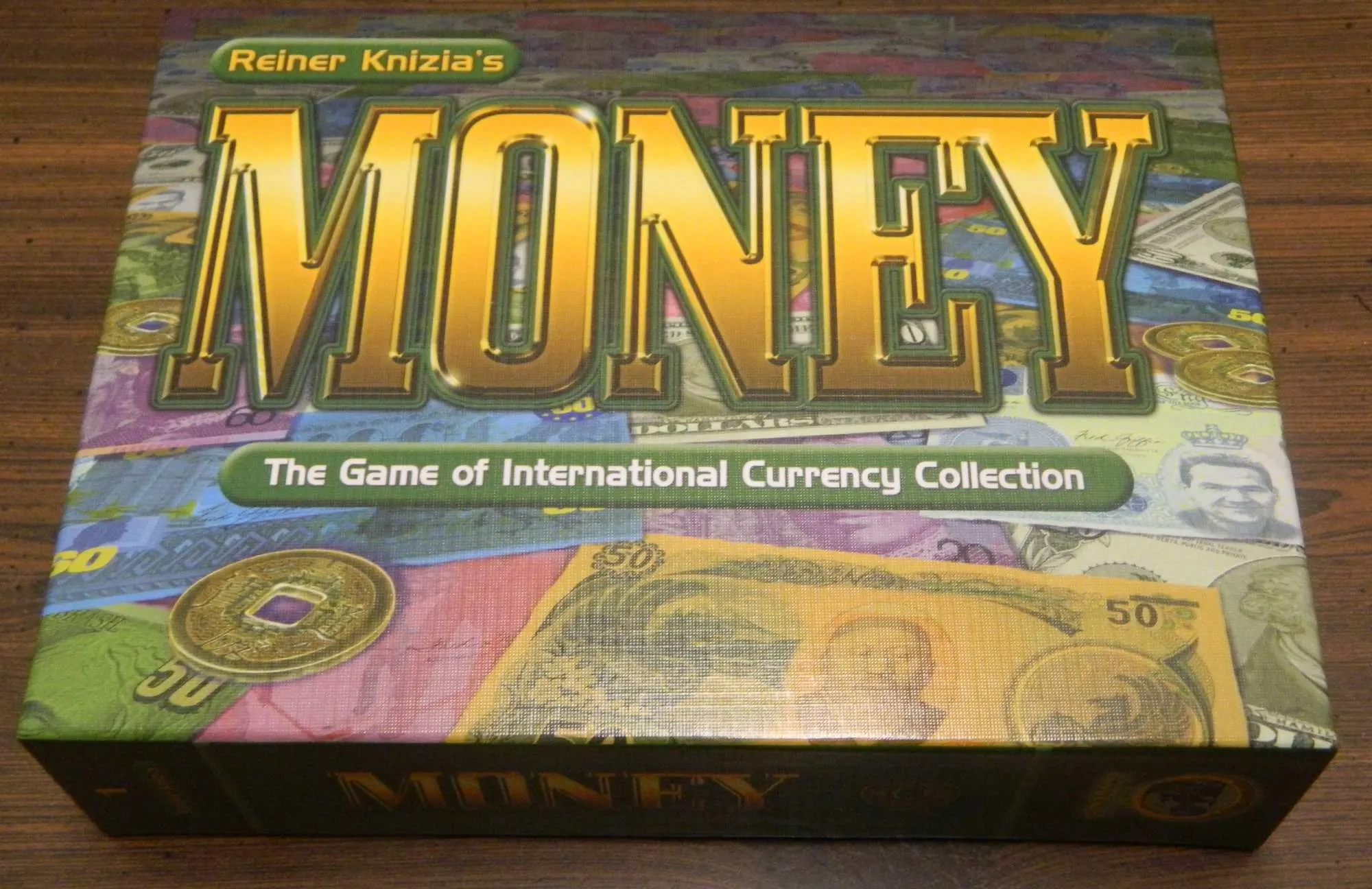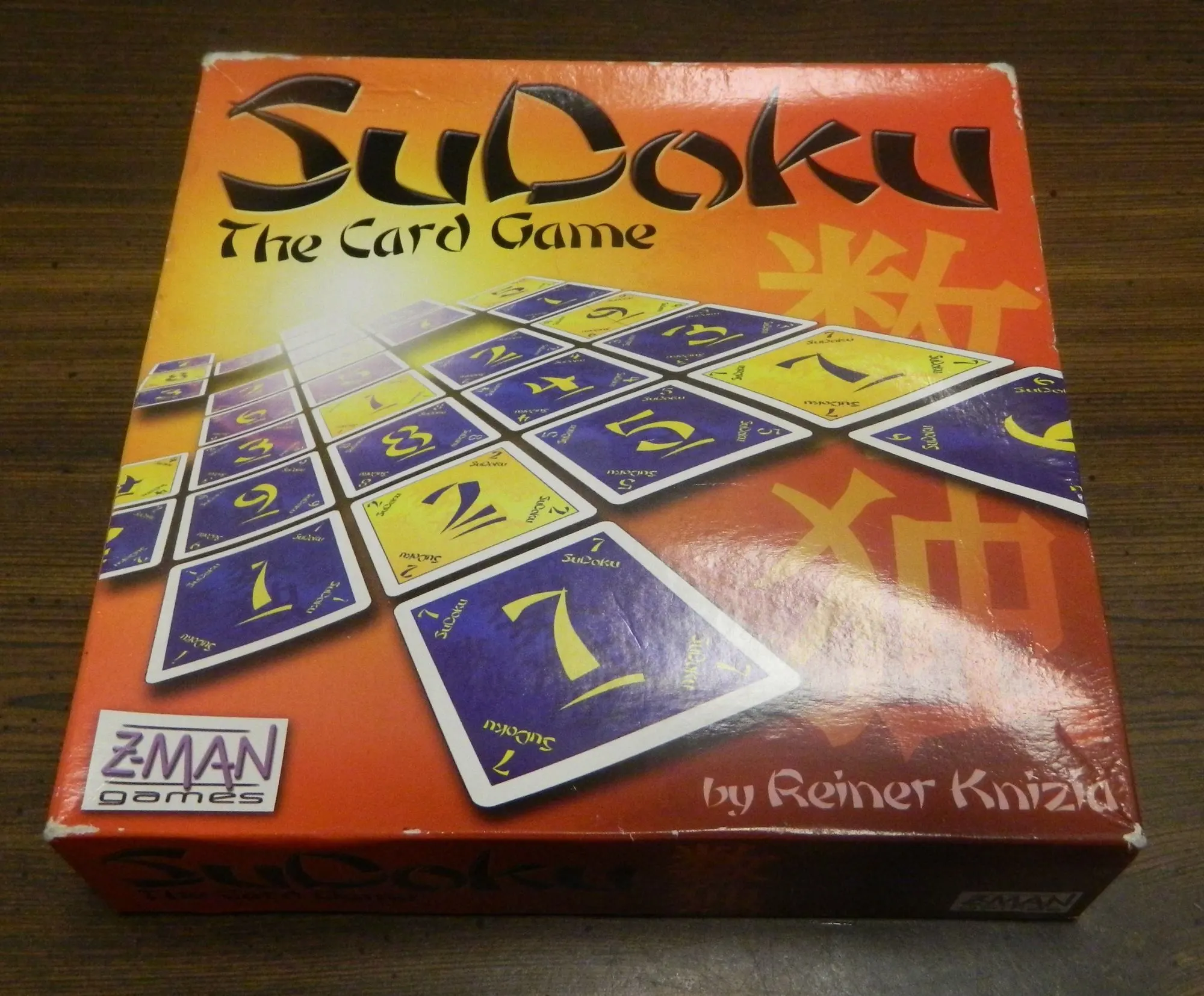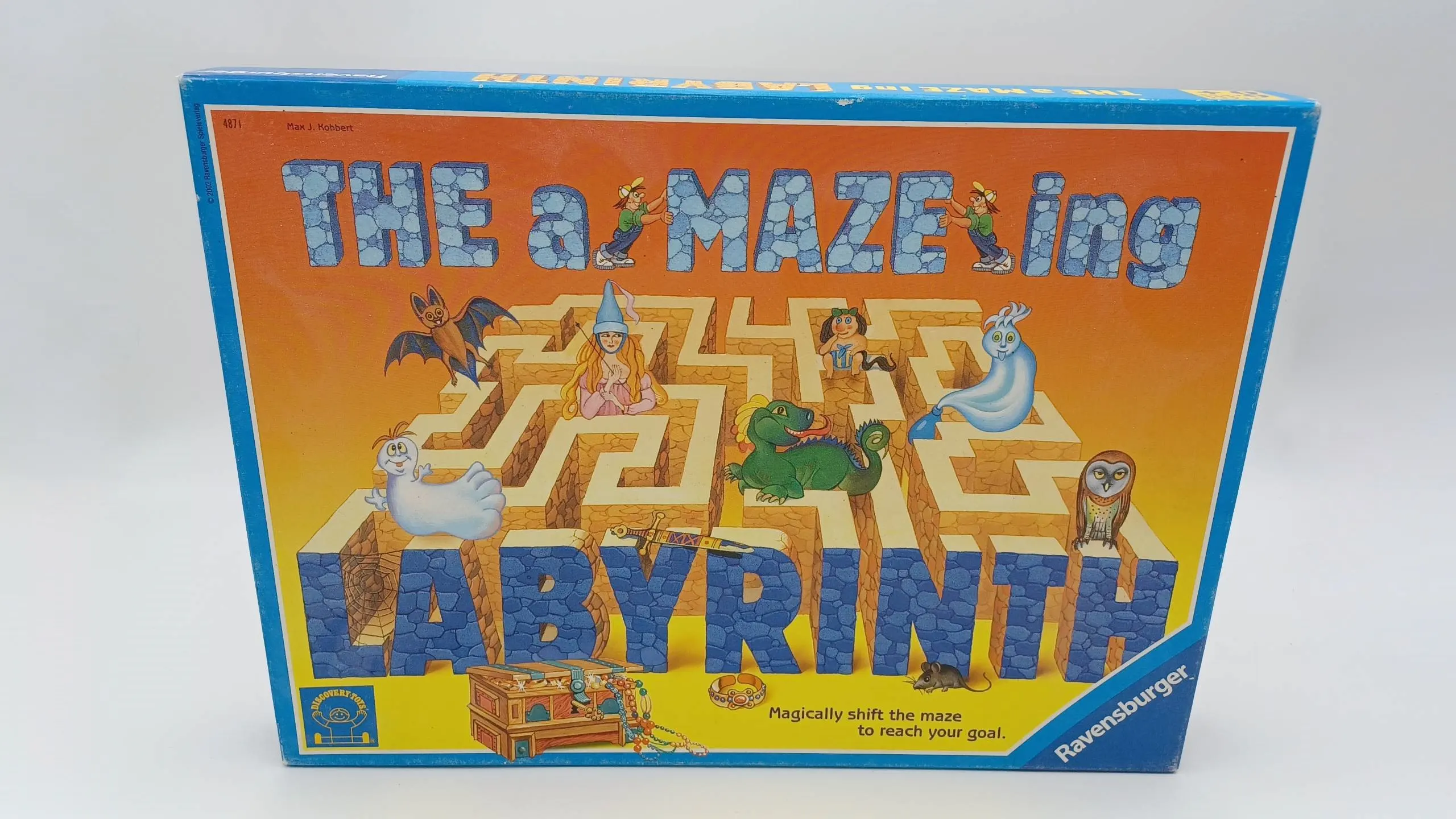Created back in 1984 Tetris is generally considered one of the most popular video games ever created. The game of falling blocks still remains a classic to this day. When you look at Tetris it is a video game that you would think would transition well to board games. Quite a few designers have thought this as there have been quite a few attempts to translate Tetris (officially and unofficially) into a board game. We have even looked at a couple of them here on Geeky Hobbies (Tetris (1989), Tetris Link). Today I am looking at another in this genre of board games that doesn’t use the Tetris name but you can tell that it was heavily inspired by it. Created by Reiner Knizia (a designer whose games I really enjoy) and having been nominated for the Spiel Des Jahres in 2009, I was really interested in checking out FITS as it had all of the makings of a really good game. Despite its reliance on luck and its low amount of scoring, FITS is a great abstract tile placement game and possibly the best board game adaptation of Tetris ever made.
How to Play FITS
Setup
- Each player chooses a color. They will take all of the tiles and the game boards of that color. Each player will also take a ramp and a cover.
- Shuffle the four starting cards and the sixteen building cards separately. Each deck is placed face down on the table.
- You will need a piece of paper and a pencil to keep score.
Playing the Game
FITS is played over four rounds. Each round begins with each player preparing their game board. They will select the board corresponding to the current round and place it on their ramp so the number is at the top of the ramp. You will then put the cover on top of the game board.
After each player has set up their board for a round, each player will randomly draw one of the starting cards. Each player will find the corresponding tile and places it on their board.
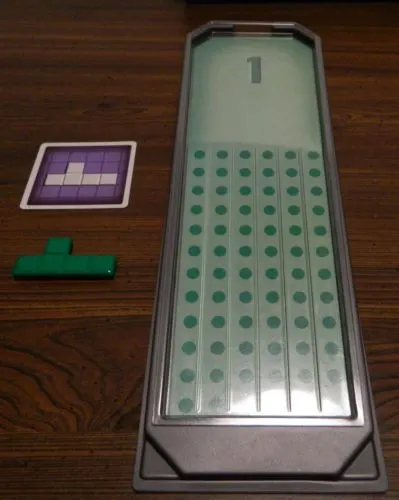
The green player drew the starting card on the left. They will have to add the corresponding piece to their gameboard.
When placing tiles on your board you must follow these rules:
- Tiles can be put in any column as long as none of the piece overlaps the edges of the board. A tile can go over the top of the grid though.
- Tiles can be turned in any direction before being placed.
- When placing a tile you will place it at the top of the ramp in the desired column. Fit the tile to the tracks on the board. When you are ready to place the tile slide it down until it is stopped by a tile that was already placed. Due to this rule you cannot place tiles into gaps that are blocked above by other tiles.
After everyone has placed their starting tile you will turn over the first building card. This card will feature one of the tiles. All of the players will now place this tile following the rules above. A player can choose not to place the tile, but this will be the only opportunity to play it in the round. If a player has already used this tile because it was their starting tile, the player will skip this turn.
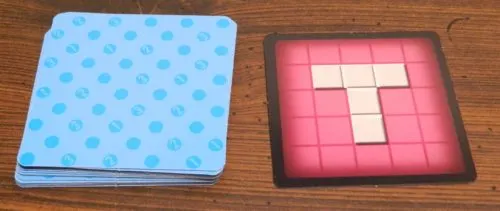
This is the first building tile flipped over this round. Each player will take their T shaped piece and have the opportunity to add it to their board.
Once everyone has placed or chosen not to place the tile the next building card is flipped over. Players will then place this tile. This continues until all of the building cards have been revealed. At this point you will tally each player’s score for the round.
Scoring
Each player will score their own board. Players will lose one point for each non-special space (see below for boards 2-4) that is not covered up.
Players will score points in different ways for each board.
In the first board players will score one point for each horizontal row that is completely filled in with tiles.
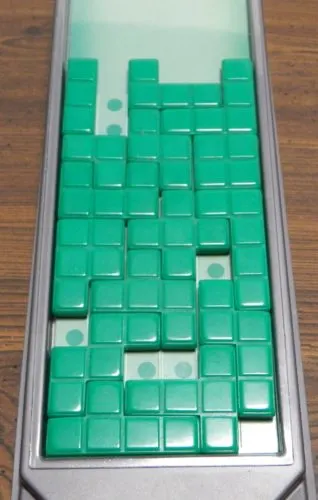
In the first round the green player has filled in six rows which will score them six points. The player failed to fill in seven spaces so they will lose seven points. In total the player will lose one point in this round.
For the second board there are special spaces scattered around the board. Each of these spaces that are left uncovered at the end of the round will score the corresponding number of points.
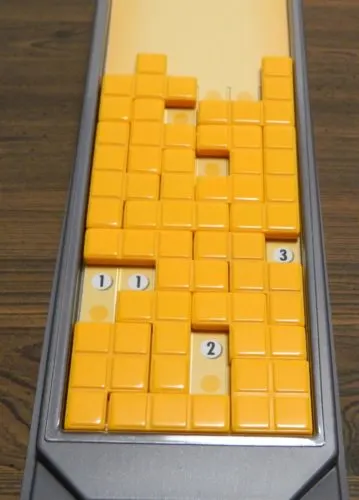
In the second round the yellow player has scored seven points for the uncovered white spaces (2 + 1 + 1 + 3). The player will lose six points for the uncovered normal spaces. The yellow player will score one point for the second round.
The third board has both positive and negative special spaces. Each of these spaces that are visible at the end of the round will be worth the corresponding number of points.
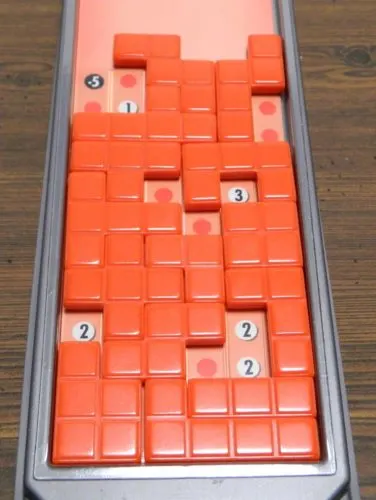
In the third round the red player will score ten points for the uncovered white spaces (2 + 2 + 2 + 3 + 1) and lose five points for the black -5 space. The player will also lose seven points for the uncovered normal spaces. The red player will lose two points for the third round.
In the fourth round there are symbols scattered around the board. There is a pair of each symbol on the board. At the end of the round you will score three points for each pair of symbols that are still visible. For each symbol where only one of the two symbols are visible you will lose three points. If you cover up both symbols of a pair you won’t gain or lose any points.
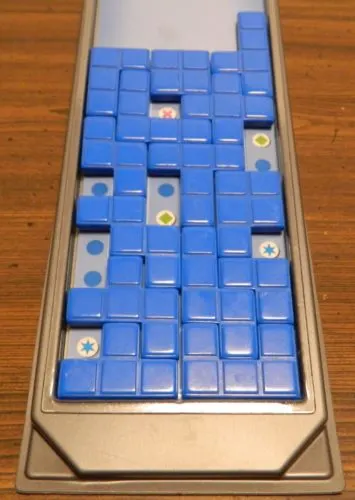
In the fourth round the blue player kept the two stars, two diamonds, and one of the Xs uncovered. They will score three points for the stars and three points for the diamonds. They will lose three points for the X as they covered the other copy of the symbol. The player will also lose five points for the uncovered normal spaces. The blue player will lose a total of two points from the round.
After everyone has finished tallying their score they will remove the tiles from their board. Everyone will add the board for the next round to their ramp. All of the starting and building cards are shuffled to prepare for the next round. The next round will then be played in the same matter as the first round.
End of Game
The game ends after all four rounds have been played. The player who scores the most points between all four rounds wins the game. If there is a tie all tied players will share the victory.
Single Player
If you are playing the game single player you will play the game normally. To determine how well you did you will compare your score to the following chart:
- 30+ points: master builder
- 26-30: architect
- 21-25: stone mason
- 16-20: handyman
- 11-15: landscaper
- 6-10: the new guy
- 5 or lower: clean up crew
My Thoughts on FITS
This may be oversimplifying things to a degree, but FITS is basically the board game equivalent of Tetris. In the game you are given a set of pieces comprised of a number of bricks. These shapes are similar to Tetris pieces but not exactly the same. A card is drawn and each player has the opportunity to add the corresponding piece to their gameboard. All pieces must be slid from the top of the gameboard until they are stopped by a piece that was already placed on the gameboard. The goal is to place your pieces in a way where you fill in most of the spaces while leaving some of the special spaces unoccupied in order to score points. The player that scores the most points ultimately wins the game.
The two games may not be exactly the same but FITS is about as close as you can get to Tetris and still have it work as a board game. Having played a couple other board games that have utilized a Tetris-like mechanic FITS is the best board game that I have played that utilizes these type of mechanics. I think this is because the game takes the Tetris gameplay and finds the elements that would work well in a board game setting. This is not surprising as it was designed by Reiner Knizia who is credited with over 500 board games to his name. Reiner Knizia took his experience with the board game industry and used it to craft mechanics for a Tetris game that would work well in a board game. Outside of adding a real time mechanic to the game I don’t know how much more you could do with this Tetris genre of board games. FITS has a couple issues which I will get to later, but the game is really enjoyable and a great game for a number of reasons.
Any long time readers of Geeky Hobbies will know that my motto for board games is that a game should never be made more difficult than it needs to be. If a mechanic just adds complexity to a game without adding much enjoyment it should be removed as the game should just focus on what makes the game enjoyable. Having played quite a few games created by Reiner Knizia I knew before I even looked at the rules that FITS would be accessible. My initial hunch was correct as the game is really easy to play. Anyone familiar with Tetris could probably learn the game in a few minutes. The mechanics are really straightforward. The only mechanic that isn’t immediately obvious is the scoring for some of the rounds. The scoring is not all that difficult to explain either. If players aren’t familiar with Tetris it may add a couple more minutes to the explanation. In all situations though you should be able to teach the entire game within five or so minutes. With the game being so simple it should not come as a surprise that the game is accessible for the whole family. The game has a recommended age of 8+ which is a good recommendation even if some kids even younger could play the game. I think the whole family can enjoy the game as it is simple enough for children and yet contains enough strategy to keep adults interested.
With the game being so simple it also plays pretty quickly. The length is going to somewhat depend on the number of players and how long it takes players to make decisions. The game has a total of four rounds with each round taking around five to ten minutes. Therefore I see most games only taking around 30-45 minutes. For this type of game I found FITS to play quite quickly. These type of games generally take at least an hour. I appreciate the shorter length as I would rather play a game that is short and sweet over a game that drags itself out. I attribute the game playing so quickly to the fact that all of the players play at the same time. Players don’t have to wait around for the other players to decide what they themselves want to do. This leads to little downtime in the game. If you want an even shorter game you could even choose to cut out some of the rounds. The only thing that may make the game take longer is if players have trouble making decisions. In most cases it is obvious where you should place your next piece. Players that suffer from analysis paralysis can drag out the game if they have to always make sure they make the best move.
I think the best thing about FITS though is that the game is just cleverly designed. The main gameplay is the same as Tetris, but the scoring has been tweaked so the game works well as a board game. Ultimately the goal in the game is to cover as many of the normal spaces as possible while avoiding the special spaces. This requires clever use of your pieces as you can’t choose your next piece. You need to use whatever piece you are given next. Sometimes these pieces work with your current layout and other times they don’t. For the times that the tiles don’t work well you need to get creative. Luck plays a role as well, but the player that is best at figuring out how to place their pieces well will have a big advantage in the game.
This is topped off by the idea that the game features four different rounds. The main gameplay is the same between the four rounds, but how you score points differs. In each round you are trying to cover up as many of the generic spaces as possible as each you don’t cover is worth negative points. How you score positive points changes with each round. Most of the rounds include special spaces that score you points if you don’t cover them up. There are also some spaces that provide negative points if they aren’t covered up. Thus your goal is more than just covering up all of the spaces. You need to figure out how to place your pieces to cover up most of the generic spaces while trying not to cover up these special spaces. This requires some skill and is one of the things that really makes the game. I kind of wish the game included more types of rounds, but people have created their own boards that you can use to keep the game fresh. The game even has an official expansion from Reiner Knizia which adds four boards to the game. These different ways of scoring rounds don’t drastically change the gameplay, but they keep the game fresh.
As FITS is basically the board game equivalent of Tetris your enjoyment will likely depend on your opinion of Tetris. If you have never liked Tetris you won’t like FITS. If you love Tetris or at least don’t mind it I think you will really enjoy FITS. The game is quite fun as it is a good abstract tile placement game. The game may not always go your way, but it is surprisingly satisfying when you are able to use the tiles well. People who generally like these type of games should really enjoy FITS.
While I really enjoyed FITS it does have a couple issues.
I would say that the biggest issue with the game is the fact that the game relies on more luck than you would expect. In the game you have no choice over what piece you are going to have to play next as it is determined by card draw. You could do a good job filling in every generic space until you get to a point where you need a very specific piece. Get that piece and you will be in a good position. Get a piece that doesn’t work with your current layout though and you have two options. First you can choose not to play the piece which likely means that you won’t have enough pieces to cover all of the spaces towards the top of the gameboard. Otherwise you are forced to play the piece which can mess up your entire strategy and leave a bunch of empty spaces that you won’t be able to cover. Players that are better at placing their pieces should usually win, but you also need to hope that luck is on your side.
For this type of abstract strategy game it is a little disappointing that the game relies on more luck than your would expect. Unfortunately I don’t know how much you can do fix it either. If you let players place pieces in whichever order they prefer the game would become boring pretty quickly as you would follow the same strategy every game. The randomness keeps the game interesting as you don’t know what is going to happen next. I wish the luck could be limited some though. Maybe players could draw a couple cards at a time and the players could choose the order in which they would play these tiles. This would give players more options without eliminating the luck entirely.
In addition to relying on a decent amount of luck FITS can also be kind of cruel to players. Simply put don’t expect to score a lot of points in the game. Based on how the scoring is conducted you won’t score many points most rounds. Unless you are really lucky you can expect to only score a couple points each round. It is not even that surprising to score zero or negative points in a round. The problem is that you lose a point for each uncovered generic space. Unless you get the right pieces at the right time it usually means that you will leave a number of spaces uncovered. This is supposed to be offset by the points you score each round. Unfortunately it is hard to score many more points than you have to give up in penalties. You should be able to improve your scores the more you play the game. For your first couple of games though it is not surprising to score ten or less points. Based on the single player scoring even getting a score above thirty means that you are a master at the game. I honestly don’t see ever getting that many points in one game unless you are really lucky.
My final complaint with FITS is that the game doesn’t have a lot of player interactions. Basically each player plays their own game and players then compare their final scores at the end of the game. This is not that surprising as the game has a solo mode that doesn’t change any of the main mechanics outside of forcing you to compare your final score to a chart. This is not as bad as some other games as it moves pretty quickly as everyone plays at the same time. For people that like player interaction in their games though they likely will be disappointed. I am not sure that Reiner Knizia really deserves blame for this fact though. I don’t know how you really could have added much more player interaction into this type of board game.
Before wrapping up I would like to say that I thought the game’s components were quite good. I liked the gameboards as it is easy to change between rounds and they hold the pieces well as you slide them down. I do wish the game included a few more round boards though to add a little more variety. You could easily create your own boards though or print out some of the boards already created by other players. I also thought the plastic pieces were nice. They are of a thicker plastic and are sturdy enough that they work well. The game’s artwork is kind of basic, but I think it works well for the game. The components may not wow you, but they do a very good job serving their purpose in the game.
Should You Buy FITS?
FITS is basically Reiner Knizia’s take on a board game adaptation of Tetris. Basically you are given various pieces and you have to fit them inside your grid in order to maximize your score. I had a lot of fun with FITS. The gameplay may be similar to Tetris, but there are some small tweaks especially with the way the different rounds are scored that keep the game fresh. FITS is really easy to teach and play. It also plays quickly. There is enough strategy in the game to keep players of any age interested. Basically anyone who has any interest in Tetris’ gameplay should really enjoy playing FITS. FITS does rely on quite a bit of luck at times though as your fate will depend on whether a tile card is drawn that works with your current layout. Players are also unlikely to score a lot of points in the game and it doesn’t have a lot of player interaction.
If you have never liked Tetris’ gameplay I don’t see FITS appealing to you. People who have any interest in Tetris though should really enjoy FITS as it is probably the best Tetris style board game that I have ever played. If you are at all interested in a Tetris board game I would highly recommend picking up FITS.

